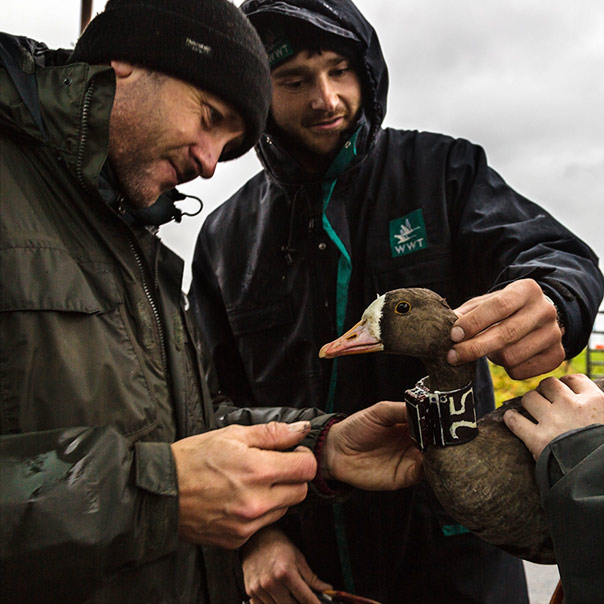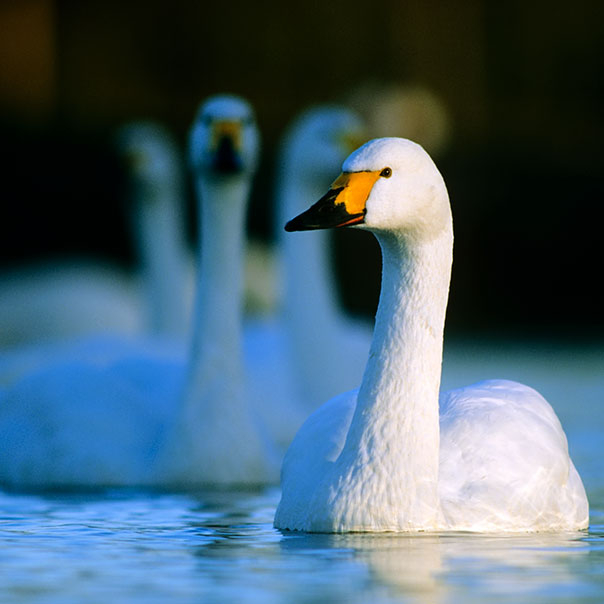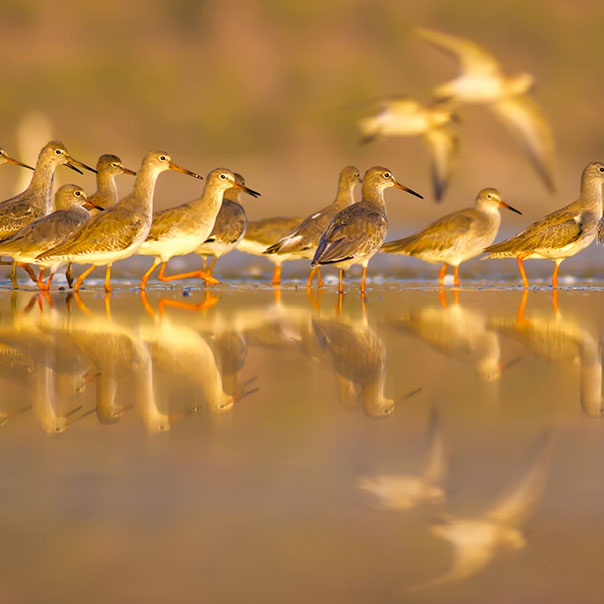Geese found in UK wetlands
The UK hosts seven species of geese that breed in far northern countries and arrive here in the autumn to spend the winter in relative warmth.
Five species belong to the so-called ‘grey geese’ of the Anser genus; these are large, predominantly grey birds. The other two are the barnacle and brent goose. These birds belong to the Branta genus (from an Old Norse word meaning ‘black’ or ‘burnt’).
What makes a goose a goose?
All geese are large, heavy birds. They have strong legs and feet for walking but are also adept at being on the water and can search for food underwater, making wetlands the perfect home for them. They’re a gregarious bunch and can form very large wintering flocks when on migration. All geese are monogamous and pair for life.
Where do geese live?
The geese covered below winter in wetlands from western Europe right across to the Caucasus. Their breeding grounds are in the far north, mostly within the arctic circle, from Canada across Greenland, Iceland, Svalbard and the vast Russian tundra.
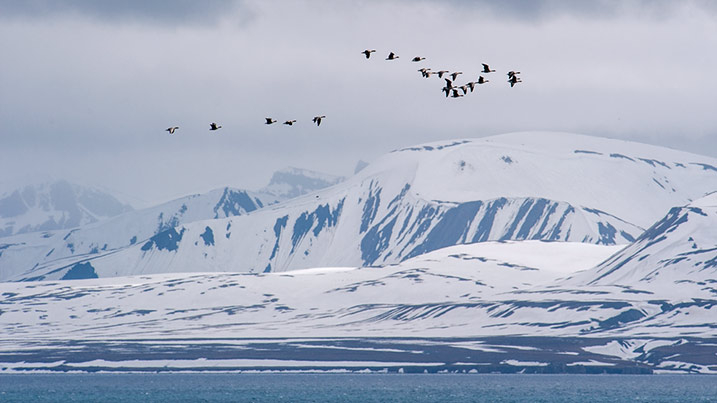
What do geese eat?
Geese are primarily grazers, but different species enjoy different grasses. Some are comfortable on farmland or saltmarsh, whereas some feed on more aquatic foodstuffs, like the brent goose and their favourite food, eelgrass.
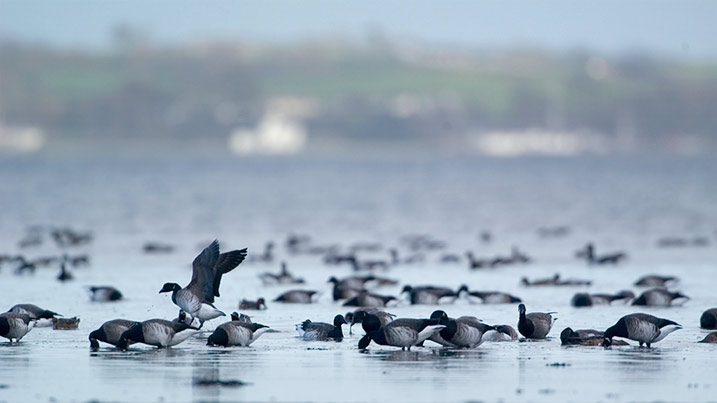
A guide to geese you might see in the UK
Greylag goose
Anser anser
The large size and pale feathers of the greylag distinguish it from other Anser geese. The heavy bill is orange and the legs are pink. It has very pale upperwings in flight. The only native species of goose to breed in Britain, but numbers in winter are increased by Icelandic birds. Greylags are the ancestors of most domestic geese breeds, thought to have first occurred around 3000 years ago in Ancient Egypt.
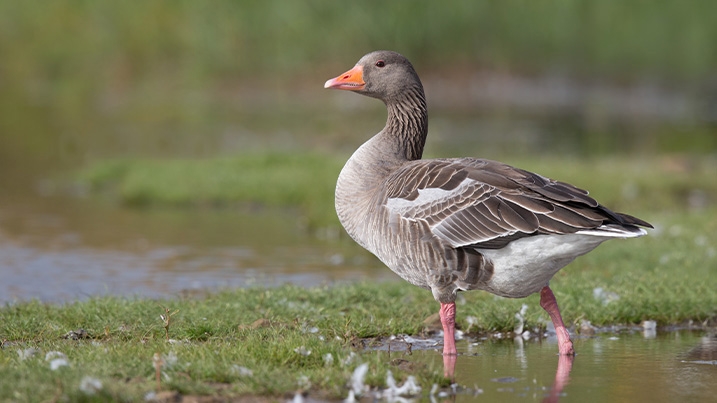
Pink-footed goose
Anser brachyrhynchus
One of our smaller geese, with a relatively short neck; dark, rounded head; short, pink bill; grey-brown plumage and pink legs. Pale upperwings in flight. Breeds in Iceland and flies south to winter in mid-northern wetlands of England and across Scotland.
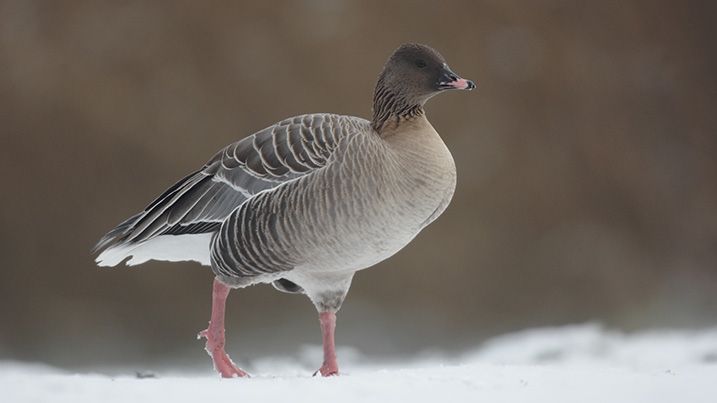
Russian white-fronted goose
Anser albifrons albifrons
After breeding on the tundra, we see these birds arriving in autumn to spend the winter, mostly in the south and east. It has a pink bill. Britain is on the western most fringe of their wintering range so numbers vary greatly depending on how bad the winter weather is in any given year.
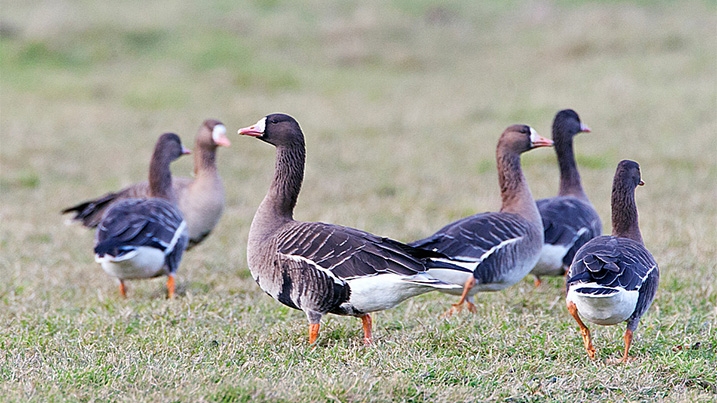
Greenland white-fronted goose
Anser albifrons flavirostris
Breeds in Greenland and winters in Ireland and western Scotland. It mainly differs from its Russian cousins in having an orange bill. Key ID features are the white patch on the forehead, orange legs and black belly stripes.
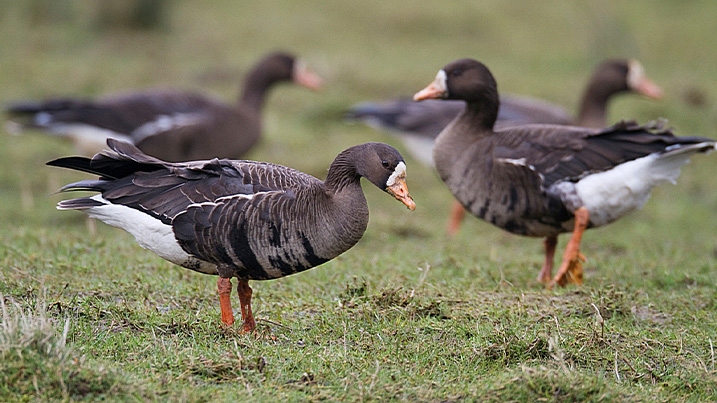
Taiga bean goose
Anser fabalis
Darker and browner than other geese in this group, the bean goose has a dark head, long slim neck and black and orange bill. Usually a longer beak with more orange than black. Breeds on marshes around the taiga. Both bean geese are fairly scarce visitors to Britain.
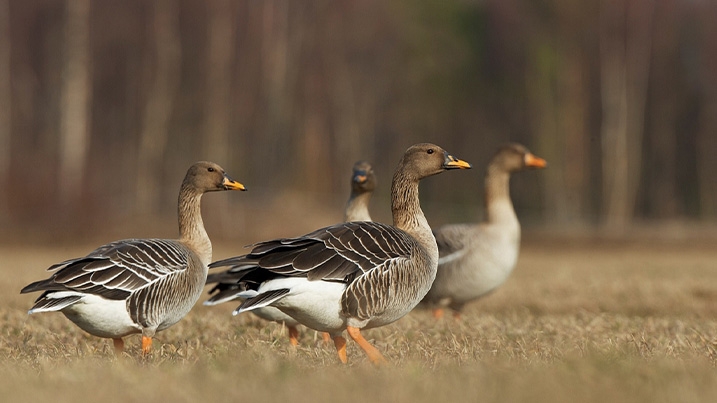
Tundra bean goose
Anser rossicus
Slightly smaller than fabalis, due to this and their slightly smaller, darker head and shorter neck can even be confused with pink-footed geese. Additionally, tundra bean geese usually have a short beak with more black than orange; this differs them from the taiga but is another similarity with the pink-footed and can be easily confused when viewed at a distance.
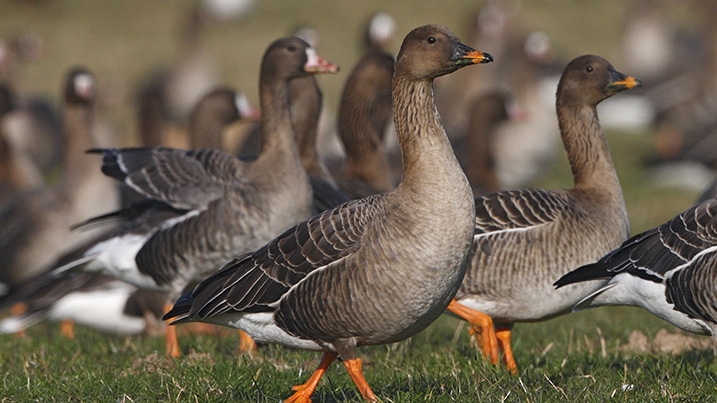
Dark-bellied brent goose
Branta bernicla bernicla
Plumage dark below, only slightly lighter than upperparts. These geese race here from Russian winters mainly to South and East England. Can often be seen resting on the sea. These geese are only slightly larger than a mallard, dark in colour with black plumage from the breast upwards and a small white crescent under their chin.
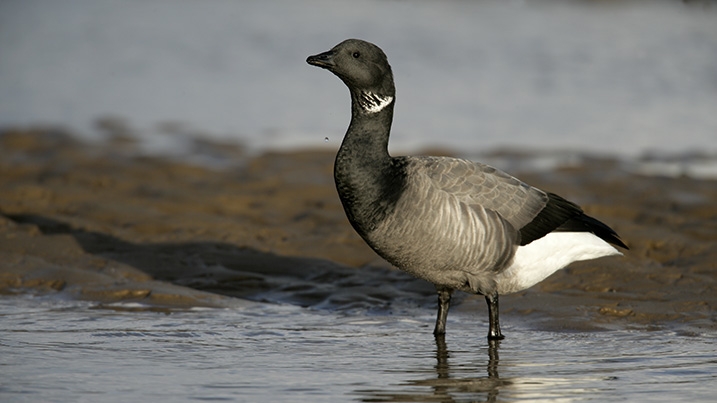
Light-bellied brent goose
Branta bernicla hrota
Plumage light below, contrasting strongly with dark upperparts. Most of these birds breed in the East Canadian arctic and undertake one of the longest goose migrations, to winter in Ireland. They feast on the eelgrass at sites such as Strangford Lough but once this is depleted, they will disperse around the coastline and are even found grazing in parks in Dublin.
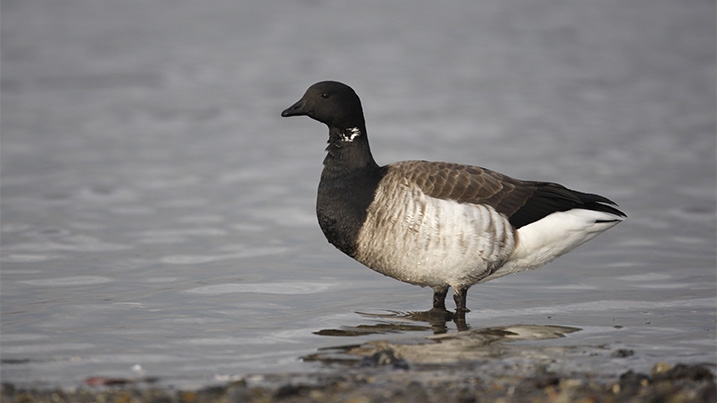
Barnacle goose
Branta leucopsis
The same dark chests and necks as the brents but with a white face, even paler underbellies and even darker backs. The barnacle geese seen at WWT Caerlaverock breed on the Svalbard archipelago of northern Norway and winter on the Solway Firth.
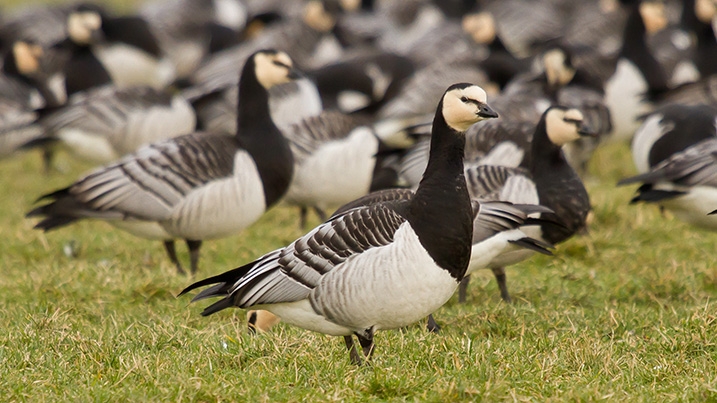
Canada goose
Branta canadensis
Light brown in colour with a pale chest, black neck and face. A wide white patch stretches under the neck. First introduced from the Americas in the 17th century, these birds are now a familiar site both in parks and nature reserves across the country. They’re our largest goose and often aren’t afraid to say hello!
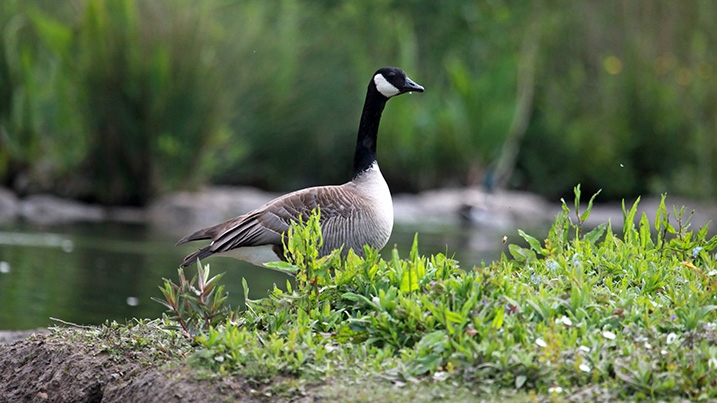
Egyptian goose
Alopochen aegyptiaca
This brightly coloured goose was introduced from Africa in the 18th century. What they lack in size they make up for in personality – they can be loud and aggressive! Most commonly seen in parks or on golf courses.
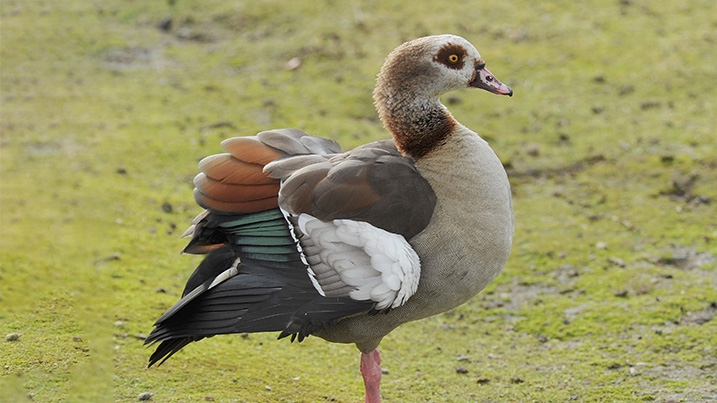
My goose doesn’t look like any of the above…
It’s likely to be a domestic breed, a descendant of selective breeding from greylags. Those domestics can interbreed with one another and wild birds. It’s even possible for wild species to hybridise, like Canadas and greylags. Another possibility is that it's another escaped, feral species, such as bar-headed geese.
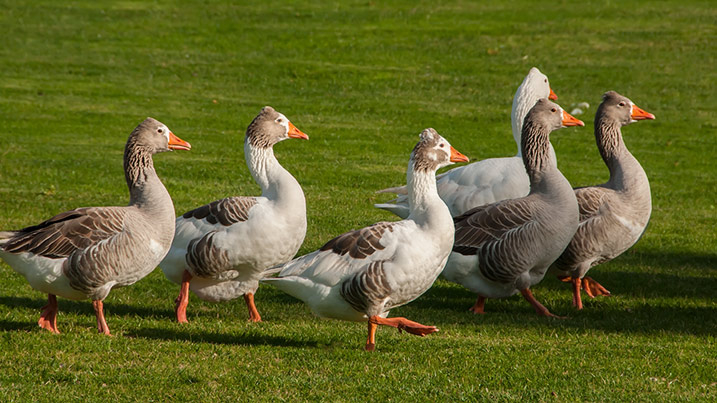
Additionally, you might come across a juvenile of any of the above described wild geese. Generally this means less well-defined plumage and a lack of key identifying features, for example, no white-front on white-fronts! It can take years of study to become confident in goose ID.
How WWT are helping
Since the 1940s, WWT has been heavily involved in waterbird monitoring. It was Sir Peter Scott’s concern over declining numbers of geese that was a major reason to create the then ‘Severn Wildfowl Trust’. To this day, WWT supports global waterbird monitoring by undertaking surveys and supporting and training other organisations.
Many goose populations have increased and stabilised in recent years, thanks to conservation efforts to protect their key sites and better regulation of hunting. However, some geese such as the Greenland white-fronted goose are declining - see the link below for more on how we're working to help them.
At our sites we manage our reserves for wetland wildlife, some of which support geese. During autumn migration, WWT Castle Espie hosts light-bellied brent geese and WWT Martin Mere hosts pink-footed geese. During the winter period, WWT Slimbridge hosts Russian white-fronted geese and WWT Caerlaverock hosts barnacle geese.
